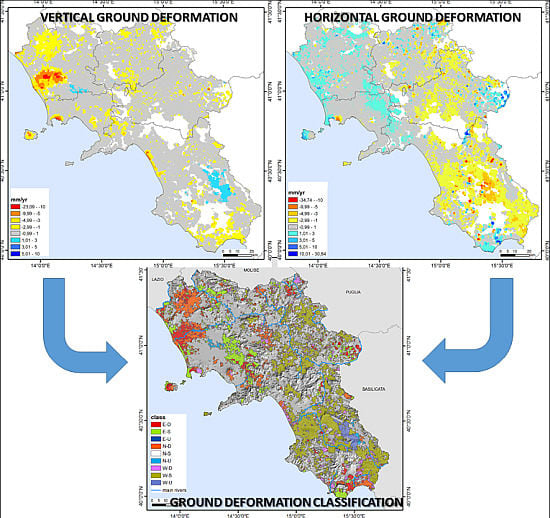Analysis and Classification of Natural and Human-Induced Ground Deformations at Regional Scale (Campania, Italy) Detected by Satellite Synthetic-Aperture Radar Interferometry Archive Datasets
Abstract
1. Introduction
2. Study Area Description
3. Materials and Methods
3.1. Persistent Scatterer Interferometry (PSI) Datasets Available for Campania Territory
3.2. PSI Datasets Post-Processing for Ground Deformation Components
3.3. PSI Datasets Post Processing for Ground Deformation Classification
- landslides, IFFI-Landslide Inventory in Italy (http://www.progettoiffi.isprambiente.it/inventario);
- faults, Geological Map of Italy (http://193.206.192.231/carta_geologica_italia/default.htm);
- active faults; GNDT-Project 5.1.2 “Inventory of active faults and associated earthquakes” (https://emidius.mi.ingv.it/GNDT/P512/home.html);
- seismogenic structures; DISS-Database of Individual Seismogenic Sources (http://diss.rm.ingv.it/diss/);
- hydrogeology structures; PTR-Regional Territorial Plan “Hydrogeological Units Map” (https://sit2.regione.campania.it/content/piano-territoriale-regionale).
4. Results
4.1. Ground Deformation Components
4.2. Ground Deformation Classification
5. Analysis of Regional to Local Ground Deformation
5.1. Coastal Plain Sectors
5.2. Volcanic Sectors
5.3. Inner Plain Sectors
5.4. Apennine Sectors
6. Discussion
7. Conclusions
Funding
Acknowledgments
Conflicts of Interest
References
- Gabriel, A.K.; Goldstein, R.M.; Zebker, H.A. Mapping small elevation changes over large areas—Differential radar interferometry. J. Geophys. Res. 1989, 94, 9183–9191. [Google Scholar] [CrossRef]
- Bürgmann, R.; Rosen, P.A.; Fielding, E.J. Synthetic aperture radar interferometry to measure Earth’s surface topography and its deformation. Annu. Rev. Earth Planet. Sci. 2000, 28, 169–209. [Google Scholar] [CrossRef]
- Strozzi, T.; Wegmüller, U.; Tosi, L.; Bitelli, G.; Spreckels, V. Land subsidence monitoring with differential SAR interferometry. Photogramm. Eng. Remote Sens. 2001, 67, 1261–1270. [Google Scholar]
- Hooper, A.; Zebker, H.; Segall, P.; Kampes, B. A new method for measuring deformation on volcanoes and other natural terrains using InSAR persistent scatterers. Geophys. Res. Lett. 2004, 31, 1–5. [Google Scholar] [CrossRef]
- Vilardo, G.; Ventura, G.; Terranova, C.; Matano, F.; Nardò, S. Ground deformation due to tectonic, hydrothermal, gravity, hydrogeological and anthropic processes in the Campania Region (Southern Italy) from Permanent Scatterers Synthetic Aperture Radar Interferometry. Remote Sens. Environ. 2009, 113, 197–212. [Google Scholar] [CrossRef]
- Tofani, V.; Raspini, F.; Catani, F.; Casagli, N. Persistent Scatterer Interferometry (PSI) Technique for Landslide Characterization and Monitoring. Remote Sens. 2013, 5, 1045–1065. [Google Scholar] [CrossRef]
- Tomás, R.; Romero, R.; Mulas, J.; Marturià, J.J.; Mallorquí, J.; Lopez-Sanchez, J.M.; Herrera, G.; Gutiérrez, F.; González, P.J.; Fernández, J. Radar interferometry techniques for the study of ground subsidence phenomena: A review of practical issues through cases in Spain. Environ. Earth Sci. 2014, 71, 163–181. [Google Scholar] [CrossRef]
- Hu, J.; Li, Z.W.; Ding, X.L.; Zhu, J.J.; Zhang, L.; Sun, Q. Resolving three-dimensional surface displacements from InSAR measurements: A review. Earth-Sci. Rev. 2014, 133, 1–17. [Google Scholar] [CrossRef]
- Crosetto, M.; Monserrat, O.; Cuevas-González, M.; Devanthéry, N.; Crippa, B. Persistent Scatterer Interferometry: A review. ISPRS J. Photogramm. Remote Sens. 2016, 115, 78–89. [Google Scholar] [CrossRef]
- Costantini, M.; Ferretti, A.; Minati, F.; Falco, S.; Trillo, F.; Colombo, D.; Novali, F.; Malvarosa, F.; Mammone, C.; Vecchioli, F.; et al. Analysis of surface deformations over the whole Italian territory by interferometric processing of ERS, Envisat and COSMO-SkyMed radar data. Remote Sens. Environ. 2017, 202, 250–275. [Google Scholar] [CrossRef]
- Di Martire, D.; Paci, M.; Confuorto, P.; Costabile, S.; Guastaferro, F.; Verta, A.; Calcaterra, D. A nation-wide system for landslide mapping and risk management in Italy: The second Not-ordinary Plan of Environmental Remote Sensing. Int. J. Appl. Earth Obs. Geoinf. 2017, 63, 143–157. [Google Scholar] [CrossRef]
- Terranova, C.; Iuliano, S.; Matano, F.; Nardò, S.; Piscitelli, E.; Cascone, E.; D’Argenio, F.; Gelli, L.; Alfinito, M.; Luongo, G. The TELLUS Project: A satellite-based slow-moving landslides monitoring system in the urban areas of Campania Region. Rend. Soc. Geol. Ital. 2009, 8, 148–151. [Google Scholar]
- Terranova, C.; Ventura, G.; Vilardo, G. Multiple causes of ground deformation in the Napoli metropolitan area (Italy) from integrated Persistent Scatterers DinSAR, geological, hydrological, and urban infrastructure data. Earth-Sci. Rev. 2015, 146, 105–119. [Google Scholar] [CrossRef]
- Vilardo, G.; Isaia, R.; Ventura, G.; De Martino, P.; Terranova, C. InSAR Permanent Scatterer analysis reveals fault re-activation during inflation and deflation episodes at Campi Flegrei caldera. Remote Sens. Environ. 2010, 114, 2373–2383. [Google Scholar] [CrossRef]
- Arena, L.; Cascini, L.; Ferlisi, S.; Galluccio, F.; Giulivo, I.; Matano, F.; Peduto, D. Analisi di frane lente in area urbana con il contributo dei dati PS-InSAR: il caso di Castelpagano (BN). In IARG 2012; Grafiche Turato Edizioni: Rubano, Italy, 2012; pp. 1–6. [Google Scholar]
- Iuliano, S.; Matano, F.; Caccavale, M.; Sacchi, M. Annual rates of ground deformation (1993–2010) at Campi Flegrei, Italy, revealed by Persistent Scatterer Pair (PSP)—SAR interferometry. Int. J. Remote Sens. 2015, 36, 6160–6191. [Google Scholar] [CrossRef]
- Di Paola, G.; Alberico, I.; Aucelli, P.P.C.; Matano, F.; Rizzo, A.; Vilardo, G. Coastal subsidence detected by Synthetic Aperture Radar interferometry and its effects coupled with future sea-level rise: The case of the Sele Plain (Southern Italy). J. Flood Risk Manag. 2018, 11, 191–206. [Google Scholar] [CrossRef]
- Matano, F.; Sacchi, M.; Vigliotti, M.; Ruberti, D. Subsidence Trends of Volturno River Coastal Plain (Northern Campania, Southern Italy) Inferred by SAR Interferometry Data. Geosciences 2018, 8, 8. [Google Scholar] [CrossRef]
- Regione Campania—Settore Difesa Del Suolo. Progetto TELLUS WebGIS (PSInSAR). Available online: http://webgis.difesa.suolo.regione.campania.it:8080/psinsar/map.phtml (accessed on 5 November 2019).
- Regione Campania—Settore Difesa Del Suolo. Progetto TELLUS Web Page. Available online: http://www.difesa.suolo.regione.campania.it/content/category/4/64/92/ (accessed on 5 November 2019).
- Terranova, C.; Iuliano, S.; Matano, F.; Nardò, S.; Piscitelli, E. Relazione Finale Progetto TELLUS, 79 pp., Napoli, February 2009. PODIS Project of MATTM-Campania Region. Available online: http://www.difesa.suolo.regione.campania.it/content/category/4/64/92/ (accessed on 5 November 2019).
- MATTM. Not-Ordinary Plan of Environmental Remote Sensing Web Page. National Geoportal (NG) of the Italian Ministry of Environment and of Protection of Territory and Sea (MATTM). 2015. Available online: http://www.pcn.minambiente.it/GN/en/projects/not-ordinary-plan-of-remote-sensing (accessed on 5 November 2019).
- MATTM. Not-Ordinary Plan of Environmental Remote Sensing; ENVISAT Ascending E ENVISAT Descending Interferometric Products. National Geoportal (NG) of the Italian Ministry of Environment and of Protection of Territory and Sea (MATTM). 2015. Available online: http://www.pcn.minambiente.it/viewer/ (accessed on 5 November 2019).
- Semple, A.G.; Pritchard, M.E.; Lohman, R.B. An Incomplete Inventory of Suspected Human-Induced Surface Deformation in North America Detected by Satellite Interferometric Synthetic-Aperture Radar. Remote Sens. 2017, 9, 1296. [Google Scholar] [CrossRef]
- Ducci, D.; Tranfaglia, G. Effects of climate change on groundwater resources in Campania (southern Italy). In Climate Change and Groundwater; Dragoni, W., Sukhija, B.S., Eds.; Geological Society: London, UK, 2008; Volume 288, pp. 25–38. [Google Scholar]
- Bonardi, G.; Ciarcia, S.; Di Nocera, S.; Matano, F.; Sgrosso, I.; Torre, M. Carta delle principali unita cinematiche dell’Appennino meridionale e Nota illustrativa. Boll. Soc. Geol. It. 2009, 128, 47–60. [Google Scholar]
- Doglioni, C. A proposal of kinematic modelling for W-dipping subductions–possible applications to the Tyrrhenian–Apennines system. Terra Nova 1991, 3, 423–434. [Google Scholar] [CrossRef]
- Patacca, E.; Sartori, R.; Scandone, P. Tyrrhenian basin and Apenninic arcs: Kinematic relations since late Tortonian times. Mem. Soc. Geol. Ital. 1990, 45, 425–451. [Google Scholar]
- Di Nocera, S.; Matano, F.; Pescatore, T.; Pinto, F.; Senatore, M.R.; Quarantiello, R.; Torre, M. Schema geologico del transetto Monti Picentini orientali e monti della Daunia meridionali: Evoluzione tettonica e stratigrafica del settore esterno dell’Appennino meridionale. Boll. Soc. Geol. It. 2006, 125, 39–58. [Google Scholar]
- Ferranti, L.; Oldow, J.S. Latest Miocene to Quaternary horizontal and vertical displacement rates during simultaneous contraction and extension in the Southern Apennines orogen, Italy. Terra Nova 2005, 17, 209–214. [Google Scholar] [CrossRef]
- Rosi, M.; Sbrana, A. Phegrean Fields; CNR, Quaderni De La Ricerca Scientifica: Roma, Italy, 1987; Volume 114, 175p. [Google Scholar]
- Santacroce, R. (Ed.) Somma–Vesuvius; CNR, Quaderni De La Ricerca Scientifica: Roma, Italy, 1987; Volume 114, 251p. [Google Scholar]
- Chiodini, G.; Frondini, F.; Cardellini, C.; Granieri, D.; Marini, L.; Ventura, G. CO2 degassing and energy release at Solfatara volcano, Campi Flegrei. Italy. J. Geophys. Res. 2001, 106, 16213–16222. [Google Scholar] [CrossRef]
- de Lorenzo, S.; Gasparini, P.; Mongelli, F.; Zollo, A. Thermal state of the Campi Flegrei caldera inferred from seismic attenuation tomography. J. Geodyn. 2001, 32, 467–486. [Google Scholar] [CrossRef]
- Manzo, M.; Ricciardi, G.P.; Casu, F.; Ventura, G.; Zeni, G.; Borgström, S.; Berardino, P.; Del Gaudio, C.; Lanari, R. Surface deformation analysis in the Ischia island (Italy) based on spaceborne radar interferometry. J. Volcanol. Geotherm. Res. 2006, 151, 399–416. [Google Scholar] [CrossRef]
- Sepe, V.; Atzori, S.; Ventura, G. Subsidence due to crack closure and depressurization of hydrothermal systems: A case study from Mt Epomeo (Ischia Island, Italy). Terra Nova 2007, 19, 127–132. [Google Scholar] [CrossRef]
- Ferranti, L.; Oldow, J.S.; D’Argenio, B.; Catalano, R.; Lewis, D.; Marsella, E.; Avellone, G.; Maschio, L.; Pappone, G.; Pepe, F.; et al. Active deformation in Southern Italy, Sicily and southern Sardinia fromGPS velocities of the Peri-Tyrrhenian Geodetic Array (PTGA). Boll. Soc. Geol. Ital. (Ital. J. Geosci.) 2008, 127, 299–316. [Google Scholar]
- Ricco, C.; Petrosino, S.; Aquino, I.; Del Gaudio, C.; Falanga, M. Some Investigations on a Possible Relationship between Ground Deformation and Seismic Activity at Campi Flegrei and Ischia Volcanic Areas (Southern Italy). Geosciences 2019, 9, 222. [Google Scholar] [CrossRef]
- Herrera, G.; Fernández, J.A.; Tomás, R.; Cooksley Mulas, G.J. Advanced interpretation of subsidence in Murcia (SE Spain) using A-DInSAR data-modelling and validation. Nat. Hazards Earth Syst. Sci. 2009, 9, 647–661. [Google Scholar] [CrossRef]
- Hanseen, R.F. Radar Interferometry, Data Interpretation and Error Analysis; Kluwer Academic Publishers: Norwell, MA, USA, 2001; ISBN 978-0792369455. [Google Scholar]
- Costantini, M.; Falco, S.; Malvarosa, F.; Minati, F.; Trillo, F.; Vecchioli, F. Persistent Scatterer Pair Interferometry: Approach and Application to COSMO-SkyMed SAR Data. IEEE J. Sel. Top. Appl. Earth Obs. Remote Sens. 2014, 7, 2869–2879. [Google Scholar] [CrossRef]
- Ferretti, A.; Prati, C.; Rocca, F. Permanent Scatterers in SAR Interferometry. IEEE Trans. Geosci. Remote Sens. 2001, 39, 8–20. [Google Scholar] [CrossRef]
- IREA-CNR. InSAR WebGIS. Napoli Study Area. ENVISAT Dataset. Available online: http://webgis.irea.cnr.it/webgis.html (accessed on November 2019).
- Trasatti, E.; Casu, F.; Giunchi, C.; Pepe, S.; Solaro, G.; Tagliaventi, S.; Berardino, P.; Manzo, M.; Pepe, A.; Ricciardi, G.P.; et al. The 2004–2006 uplift episode at Campi Flegrei caldera (Italy): Constraints from SBAS-DInSAR ENVISAT data and Bayesian source inference. Geophys. Res. Lett. 2008, 35, 1–6. [Google Scholar] [CrossRef]
- Costantini, M.; Falco, S.; Malvarosa, F.; Minati, F. A new method for identification and analysis of persistent scatterers in series of SAR images. In Proceedings of the 2008 IEEE International Geoscience and Remote Sensing Symposium (IGARSS), Boston, MA, USA, 7–11 July 2008; pp. 449–452. [Google Scholar]
- Costantini, M.; Falco, S.; Malvarosa, F.; Minati, F.; Trillo, F. Method of Persistent Scatterer Pairs (PSP) and high resolution SAR interferometry. In Proceedings of the 2009 IEEE International Geoscience and Remote Sensing Symposium (IGARSS), Cape Town, Africa, 12–17 July 2009; Volume 3, pp. 904–907. [Google Scholar] [CrossRef]
- Berardino, P.; Fornaro, G.; Lanari, R.; Sansosti, E. A new algorithm for surface deformation monitoring based on small baseline differential SAR interferograms. IEEE Trans. Geosci. Remote Sens. 2002, 40, 2375–2383. [Google Scholar] [CrossRef]
- Lanari, R.; Mora, O.; Manunta, M.; Mallorqui, J.J.; Berardino, P.; Sansosti, E. A small baseline approach for investigating deformation on full resolution differential SAR interferograms. IEEE Trans. Geosci. Remote Sens 2004, 42, 1377–1386. [Google Scholar] [CrossRef]
- Lanari, R.; Casu, F.; Manzo, M.; Zeni, G.; Berardino, P.; Manunta, M. An overview of the Small Baseline subset algorithm: A DInSAR technique for surface deformation analysis. Pure Appl. Geophys. 2007, 164, 637–661. [Google Scholar] [CrossRef]
- Colesanti, C.; Locatelli, R.; Novali, F. Ground deformation monitoring exploiting SAR permanent scatterers. IEEE IGARSS 2002, 2, 1219–1221. [Google Scholar]
- Colesanti, C.; Ferretti, A.; Locatelli, R.; Novali, F.; Savio, G. Permanent Scatterers: Precision assessment and multi-platform analysis. IEEE IGARSS 2003, 2, 1193–1195. [Google Scholar]
- Colesanti, C.; Wasowski, J. Investigating landslides with spaceborne synthetic aperture radar (SAR) interferometry. Eng. Geol. 2006, 88, 173–199. [Google Scholar] [CrossRef]
- Ferretti, A.; Savio, G.; Barzaghi, R.; Borghi, A.; Musazzi, S.; Novali, F.; Prati, C.; Rocca, F. Submillimeter accuracy of InSAR time series: Experimental validation. IEEE Trans. Geosci. Remote Sens. 2007, 45, 1142–1153. [Google Scholar] [CrossRef]
- Finnegan, N.J.; Pritchard, M.E.; Lohman, R.B.; Lundgren, P.R. Constraints on surface deformation in the Seattle, WA urban corridor from satellite radar interferometry time series analysis. Geophys. J. Int. 2008, 174, 29–41. [Google Scholar] [CrossRef]
- Lu, Z.; Kwoun, O.; Rykus, R. Interferometric syntetic aperture radar (InSAR): Its past, present and future. Photogramm. Eng. Remote Sens. 2007, 73, 217–221. [Google Scholar]
- Massironi, M.; Zampieri, D.; Bianchi, M.; Schiavo, A.; Franceschini, A. Use of PSInSAR™ data to infer active tectonics: Clues on the differential uplift across the Giudicarie belt (Central-Eastern Alps, Italy). Tectonophysics 2009, 476, 297–303. [Google Scholar] [CrossRef]
- Amato, V.; Aucelli, P.P.C.; Corrado, G.; Di Paola, G.; Matano, F.; Pappone, G.; Schiattarella, M. Comparing geological and Persistent Scatterer Interferometry data of the Sele River coastal plain, southern Italy: Implications for recent subsidence trends. Geomorphology 2020, 351. [Google Scholar] [CrossRef]
- Franke, R. Scattered data interpolation: Test of some methods. Math. Comput. 1982, 33, 181–200. [Google Scholar]
- Mueller, T.G.; Pusuluri, N.B.; Mathias, K.K.; Cornelius, P.L.; Barnhisel, R.I.; Shearer, S.A. Map quality for ordinary kriging and inverse distance weighted interpolation. Soil Sci. Soc. Am. J. 2004, 68, 2042–2047. [Google Scholar] [CrossRef]
- Lundgren, P.; Casu, F.; Manzo, M.; Pepe, A.; Berardino, P.; Sansosti, E.; Lanari, R. Gravity and magma induced spreading of Mount Etna volcano revealed by satellite radar interferometry. Geophys. Res. Lett. 2004, 31, 8736. [Google Scholar] [CrossRef]
- Oldow, J.S.; D’Argenio, B.; Ferranti, L.; Pappone, G.; Marsella, E.; Sacchi, M. Large-scale longitudinal extension in the southern Apennines contractional belt, Italy. Geology 1993, 21, 1123–1126. [Google Scholar] [CrossRef]
- Doglioni, C.; D’Agostino, N.; Mariotti, G. Normal faulting vs regional subsidence and sedimentation rate. Mar. Pet. Geol. 1998, 15, 737–750. [Google Scholar] [CrossRef]
- Cascini, L.; Ferlisi, S.; Peduto, D.; Di Nocera, S.; Fornaro, G.; Serafino, F. A land subsidence study via DInSAR technique over large urbanised areas. In Proceedings of the Urban Remote Sensing Joint Event, Paris, France, 11–13 April 2007; pp. 1–7. [Google Scholar] [CrossRef]
- Peduto, D.; Cascini, L.; Arena, L.; Ferlisi, S.; Fornaro, G.; Reale, D. A general framework and related procedures for multiscale analyses of DInSAR data in subsiding urban areas. ISPRS J. Photogramm. Remote Sens. 2015, 105, 186–210. [Google Scholar] [CrossRef]
- Di Paola, G.; Aucelli, P.P.C.; Matano, F.; Rizzo, A. Proneness to future marine inundation of campania coastal plains (Southern Italy) in relation to their subsidence trends assessed by interferometric SAR techniques. In Earth Observation Advancements in A Changing World; AIT Series; Associazione Italiana di Telerilevamento (AIT): Firenze, Italy, 2019; Volume 1, pp. 157–161. ISBN 978-88-944687-1-7. [Google Scholar]
- Aucelli, C.P.P.; Di Paola, G.; Incontri, P.; Rizzo, A.; Vilardo, G.; Benassai, G.; Buonocore, B.; Pappone, G. Coastal inundation risk assessment due to subsidence and sea level rise in a Mediterranean alluvial plain (Volturno coastal plain e southern Italy). Estuar. Coast. Shelf Sci. 2016, 198, 597–609. [Google Scholar] [CrossRef]
- Allocca, V.; Celico, F.; Celico, P.; De Vita, P.; Fabbrocino, S.; Mattia, S.; Monacelli, G.; Musilli, I.; Piscopo, V.; Scalise, A.R. Illustrative Notes of the Hydrogeological Map of Southern Italy; Istituto Poligrafico e Zecca dello Stato: Rome, Italy, 2007; pp. 1–211. ISBN 88-448-0215-5. [Google Scholar]
- Coda, S.; Tessitore, S.; Di Martire, D.; Calcaterra, D.; De Vita, P.; Allocca, V. Coupled ground uplift and groundwater rebound in the metropolitan city of Naples (southern Italy). J. Hydrol. 2019, 569, 470–482. [Google Scholar] [CrossRef]
- De Novellis, V.; Carlino, S.; Castaldo, R.; Tramelli, A.; De Luca, C.; Pino, N.A.; Pepe, S.; Convertito, V.; Zinno, I.; De Martino, P. The 21 August 2017 Ischia (Italy) earthquake source model inferred from seismological, GPS, and DInSAR measurements. Geophys. Res. Lett. 2018, 45, 2193–2202. [Google Scholar] [CrossRef]
- Castaldo, R.; Gola, G.; Santilano, A.; De Novellis, V.; Pepe, S.; Manzo, M.; Manzella, A.; Tizzani, P. The role of thermo-rheological properties of the crust beneath Ischia Island (southern Italy) in the modulation of the ground deformation pattern. J. Volcanol. Geotherm. Res. 2017, 344, 154–173. [Google Scholar] [CrossRef]
- Selva, J.; Acocella, V.; Bisson, M.; Caliro, S.; Costa, A.; Della Seta, M.; De Martino, P.; de Vita, S.; Federico, C.; Giordano, G. Multiple natural hazards at volcanic islands: A review for the Ischia volcano (Italy). J. Appl. Volcanol. 2019, 8, 1–43. [Google Scholar] [CrossRef]
- Milia, A.; Torrente, M.M.; Bellucci, F. A possible link between faulting, cryptodomes and lateral collapses at Vesuvius Volcano (Italy). Glob. Planet. Chang. 2012, 90, 121–134. [Google Scholar] [CrossRef]
- Passaro, S.; Sacchi, M.; Tamburrino, S.; Ventura, G. Fluid vents, flank instability, and seafloor processes along the submarine slopes of the Somma-Vesuvius Volcano, Eastern Tyrrhenian Margin. Geosciences 2018, 8, 60. [Google Scholar] [CrossRef]
- Tammaro, U.; De Martino, P.; Obrizzo, F.; Brandi, G.; D’Alessandro, A.; Dolce, A.M.; Malaspina, S.; Serio, C.; Pingue, F. Somma Vesuvius volcano: Ground deformations from CGPS observations (2001–2012). Ann. Geophys. 2013, 56, S0456. [Google Scholar] [CrossRef]
- Pingue, F.; Bottiglieri, M.; Godano, C.; Obrizzo, F.; Tammaro, U.; Esposito, T.; Serio, C. Spatial and temporal distribution of vertical ground movements at Mt. Vesuvius in the period 1973–2009. Ann. Geophys. 2013, 56, S0451. [Google Scholar] [CrossRef]
- De Natale, G.; Petrazzuoli, S.M.; Troise, C.; Pingue, F.; Capuano, P. Internal stress field at Mt. Vesuvius: A model for the generation of background seismicity at a central volcano. J. Geophys. Res. 2000, 105, 16207–16214. [Google Scholar] [CrossRef]
- De Natale, G.; Troise, C.; Pingue, F.; Mastrolorenzo, G.; Pappalardo, L. The Somma-Vesuvius volcano (Southern Italy): Structure, dynamics and hazard evaluation. Earth-Sci. Rev. 2006, 74, 73–111. [Google Scholar] [CrossRef]
- Lanari, R.; De Natale, G.; Berardino, P.; Sansosti, E.; Ricciardi, G.P.; Borgstrom, S.; Capuano, P.; Pingue, F.; Troise, C. Evidence for a peculiar style of ground deformation inferred at Vesuvius volcano. Geophys. Res. Lett. 2002, 29, 9. [Google Scholar] [CrossRef]
- Giannetti, B. Origin of the calderas and evolution of Roccamonfina volcano (Roman region, Italy). J. Volcanol. Geotherm. Res. 2001, 106, 301–319. [Google Scholar] [CrossRef]
- Rouchon, V.; Gillot, P.Y.; Quidelleur, X.; Chiesa, S.; Floris, B. Temporal evolution of the Roccamonfina volcanic complex (Pleistocene), Central Italy. J. Volcanol. Geotherm. Res. 2008, 177, 500–514. [Google Scholar] [CrossRef]
- Fabbrocino, S.; Lanari, R.; Celico, P.; Termolini, G.; Zeni, G. Groundwater Pumping and Land Subsidence in the Sarno River Plain (Campania). Mem. Descr. Carta Geol. d’It. 2007, 76, 163–174. [Google Scholar]
- Cascini, L.; Ferlisi, S.; Fornaro, G.; Lanari, R.; Peduto, D.; Zeni, G. Subsidence monitoring in Sarno urban area via multi-temporal DInSAR technique. Int. J. Remote Sens. 2006, 27, 1709–1716. [Google Scholar] [CrossRef]
- Calcaterra, D.; Esposito, A.; Fuschini, V.; Galluccio, F.; Giulivo, I.; Nardò, S.; Russo, F.; Terranova, C. L’utilizzo Della Tecnica PS-Insar™ Per L’individuazione Ed Il Monitoraggio Di Sinkholes in Aree Urbanizzate Della Campania: I Casi Di Telese Terme (BN) E Sarno (SA). 2° Workshop Internazionale “I Sinkholes. Gli Sprofondamenti Catastrofici Nell’ambiente Naturale Ed in Quello Antropizzato”; Nisio, S., Ed.; ISPRA: Roma, Italy, 2009; Volume 6, pp. 931–948. ISBN 978-88-448-0400-8. [Google Scholar]
- Guerriero, L.; Confuorto, P.; Calcaterra, D.; Guadagno, F.M.; Revellino, P.; Di Martire, D. PS-driven inventory of town-damaging landslides in the Benevento, Avellino and Salerno Provinces, southern Italy. J. Maps 2019, 15, 619–625. [Google Scholar] [CrossRef]
- Cascini, L.; Peduto, D.; Pisciotta, G.; Arena, L.; Ferlisi, S.; Fornaro, G. The combination of DInSAR and facility damage data for the updating of slow-moving landslide inventory maps at medium scale. Nat. Hazards Earth Syst. Sci. 2013, 13, 1527–1549. [Google Scholar] [CrossRef]
- Calvello, M.; Peduto, D.; Arena, L. Combined use of statistical and DInSAR data analyses to define the state of activity of slow-moving landslides. Landslides 2017, 14, 473–489. [Google Scholar] [CrossRef]
- Calò, F.; Calcaterra, D.; Iodice, A.; Parise, M.; Ramondini, M. Assessing the activity of a large landslide in southern Italy by ground-monitoring and SAR interferometric techniques. Int. J. Remote Sens. 2012, 33, 3512–3530. [Google Scholar] [CrossRef]
- Calcaterra, D.; Ramondini, M.; Calò, F.; Longobardi, V.; Parise, M.; Galzerano, G. DInSAR techiques for monitoring slow-moving landslides. In Landslides and Engineered Slopes; Chen, Z., Zhang, J., Ho, K., Wu, F., Li, Z., Eds.; Taylor & Francis Group: London, UK, 2008; ISBN 978-0-415-41196-7. [Google Scholar]
- Infante, D.; Di Martire, D.; Confuorto, P.; Tessitore, S.; Tòmas, R.; Calcaterra, D.; Ramondini, M. Assessment of building behavior in slow-moving landslide-affected areas through DInSAR data and structural analysis. Eng. Struct. 2019, 199, 109638. [Google Scholar] [CrossRef]
- Di Martire, D.; Novellino, A.; Ramondini, M.; Calcaterra, D. A-Differential Synthetic Aperture Radar Interferometry analysis of a Deep Seated Gravitational Slope Deformation occurring at Bisaccia (Italy). Sci. Total Environ. 2016, 550, 556–573. [Google Scholar] [CrossRef] [PubMed]
- Di Martire, D.; Iglesias, R.; Monells, D.; Centolanza, G.; Sica, S.; Ramondini, M.; Pagano, L.; Mallorquí, J.J.; Calcaterra, D. Comparison between Differential SAR interferometry and ground measurements data in the displacement monitoring of the earth-dam of Conza della Campania (Italy). Remote. Sens. Environ. 2014, 148, 58–69. [Google Scholar] [CrossRef]
- Amicucci, L.; Barchi, M.R.; Montone, P.; Rubiliani, N. The Vallo di Diano and Auletta extensional basins in the southern Apennines (Italy): A simple model for a complex setting. Terra Nova 2008, 20, 475–482. [Google Scholar] [CrossRef]
- Serpelloni, E.; Anzidei, M.; Baldi, P.; Casula, G.; Galvani, A. Crustal velocity and strain-rate fields in Italy and surrounding regions: New results from the analysis of permanent and non permanent GPS networks. Geophys. J. Int. 2005, 161, 861–880. [Google Scholar] [CrossRef]
- Giuliani, R.; D’Agostino, N.; D’Anastasio, E.; Mattone, M.; Bonci, V.; Calcaterra, S.; Gambino, P.; Merli, K. Active crustal extension and strain accumulation from GPS data in the Molise region (central-southern Apennines, Italy). Boll. Geofis. Teor. Appl. 2009, 50, 145–156. [Google Scholar]
- Hunstad, I.; Selvaggi, G.; D’Agostino, N.; England, P.; Clarke, P.; Pierozzi, M. Geodetic strain in peninsular Italy between 1975 and 2001. Geophys. Res. Lett. 2003, 30, 1181. [Google Scholar] [CrossRef]
- Ward, S.N. Constraints on the seismotectonics of the central Mediterranean from Very Long Baseline Interferometry. Geophys. J. Int. 1994, 117, 441–452. [Google Scholar] [CrossRef]
- Ferranti, L.; Palano, M.; Cannavò, F.; Mazzella, M.E.; Oldow, J.S.; Gueguen, E.; Mattia, M.; Monaco, C. Rates of geodetic deformation across active faults in southern Italy. Tectonophysics 2014, 621, 101–122. [Google Scholar] [CrossRef]

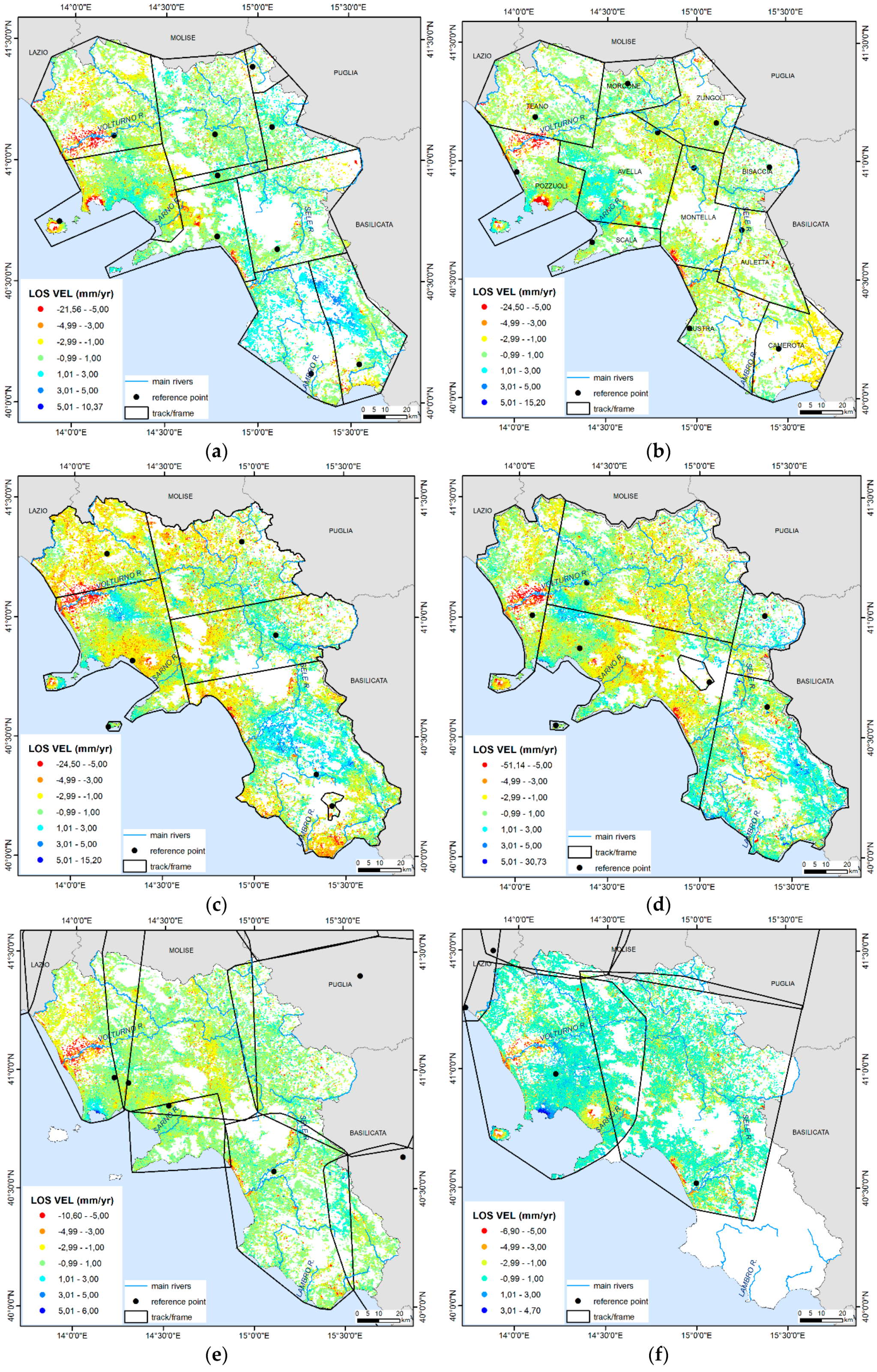
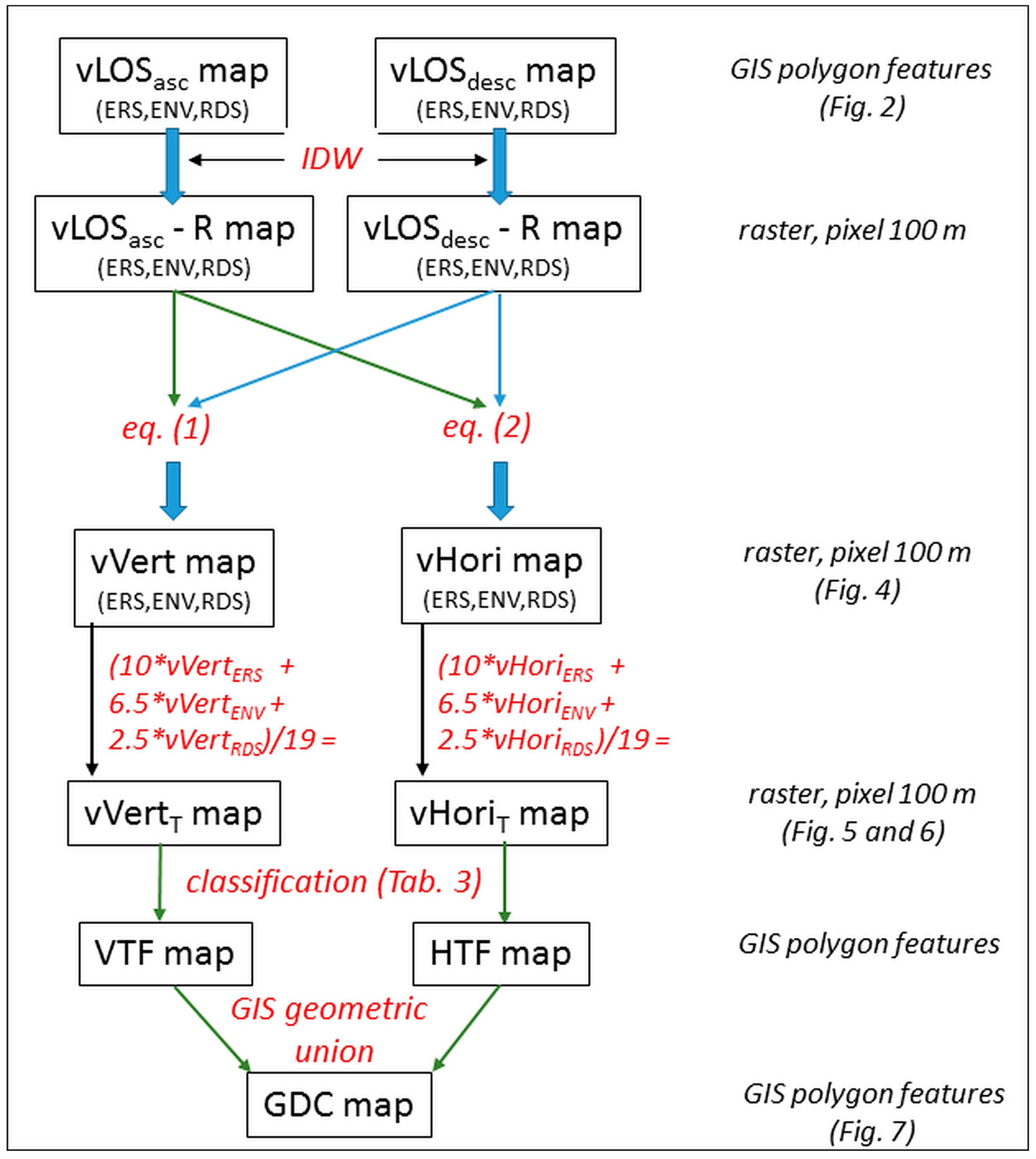


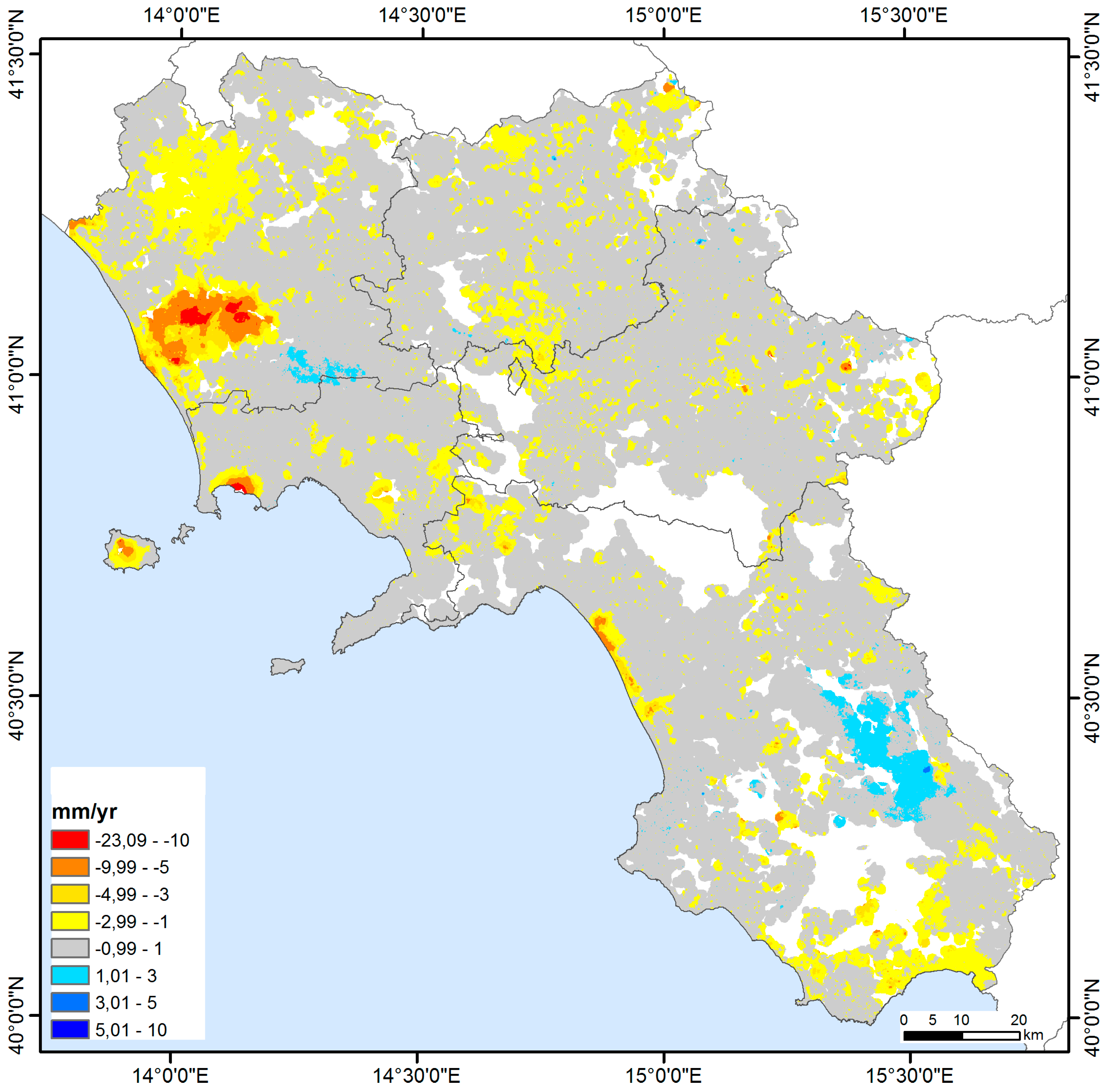
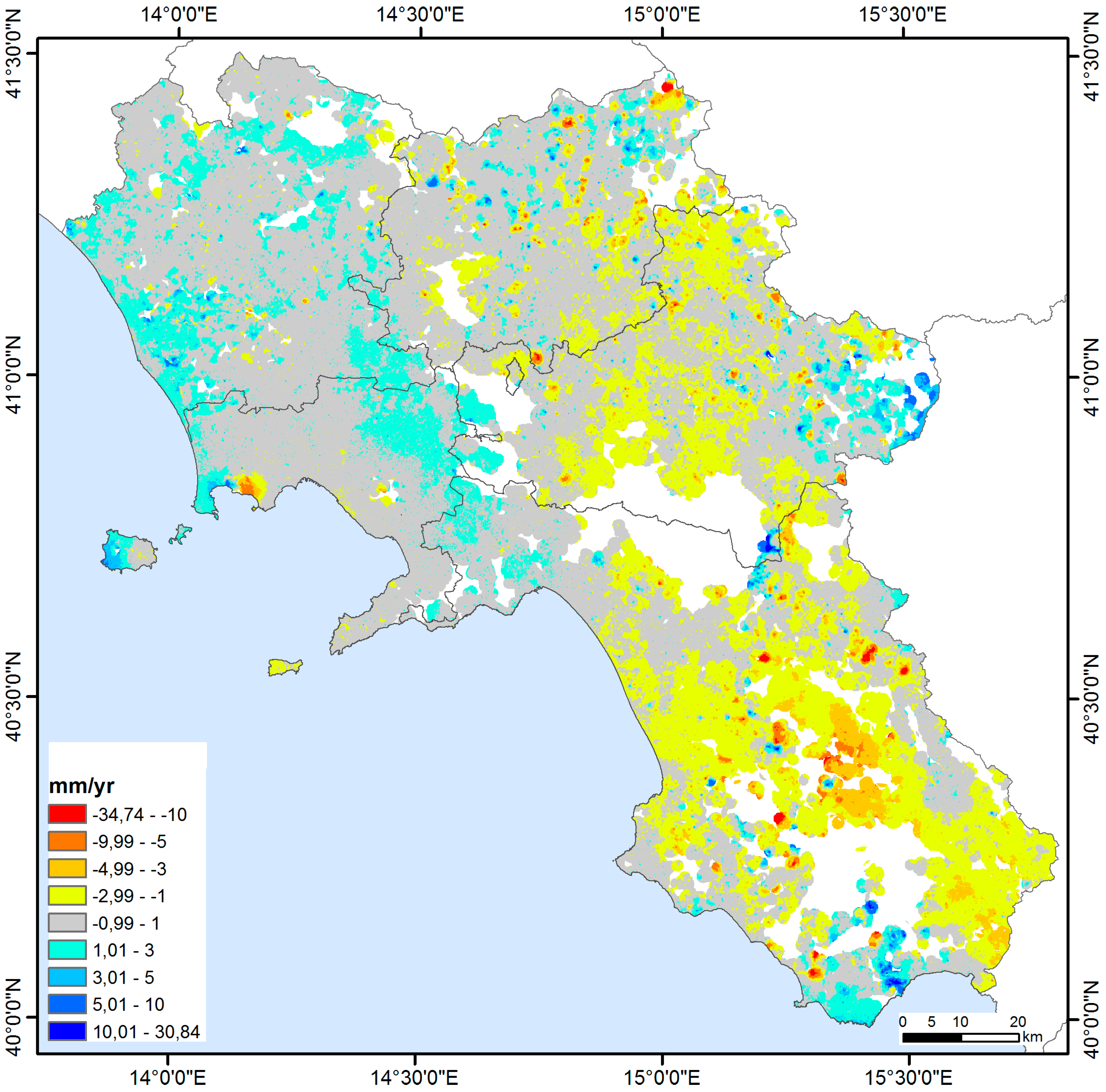
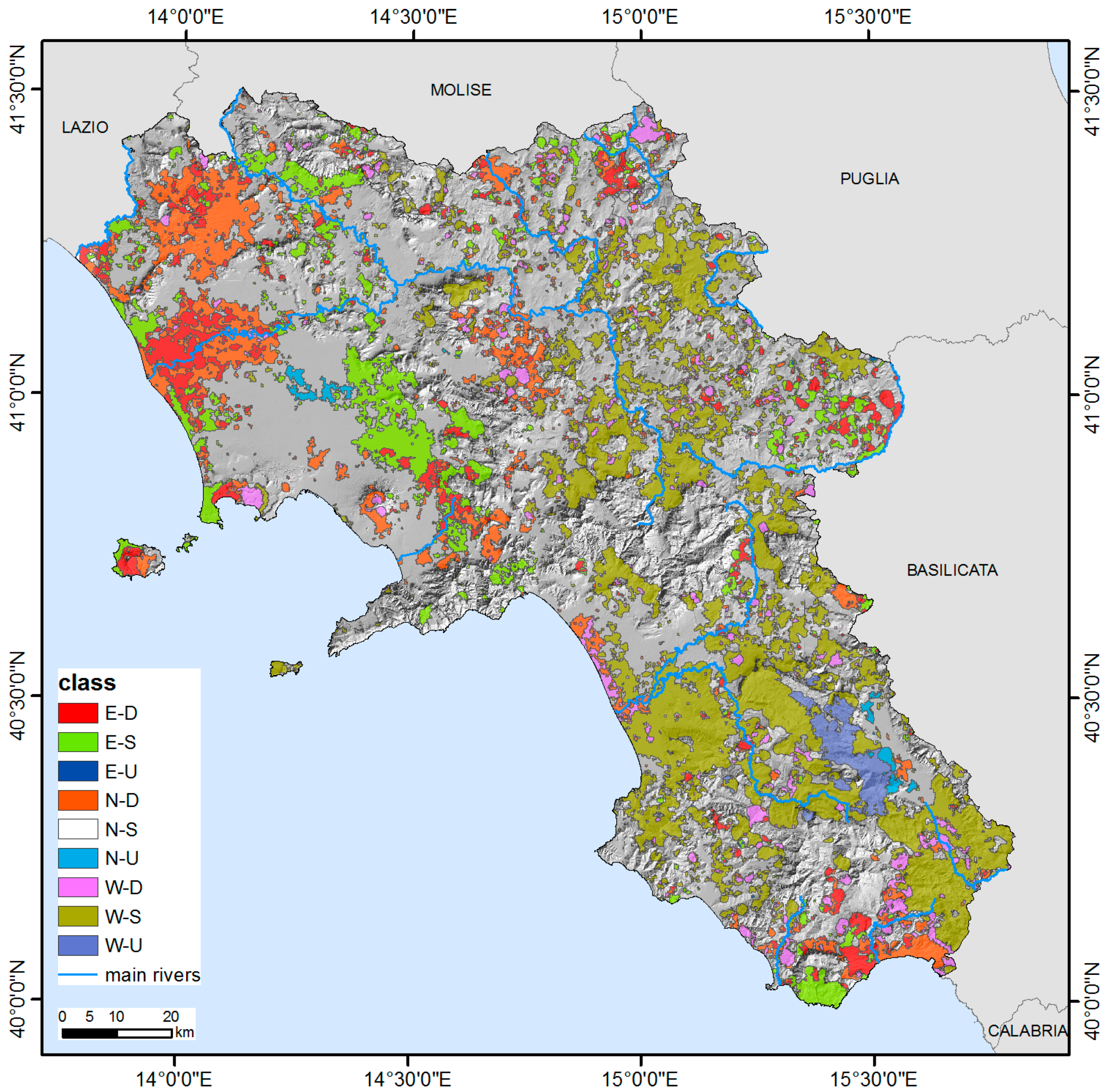
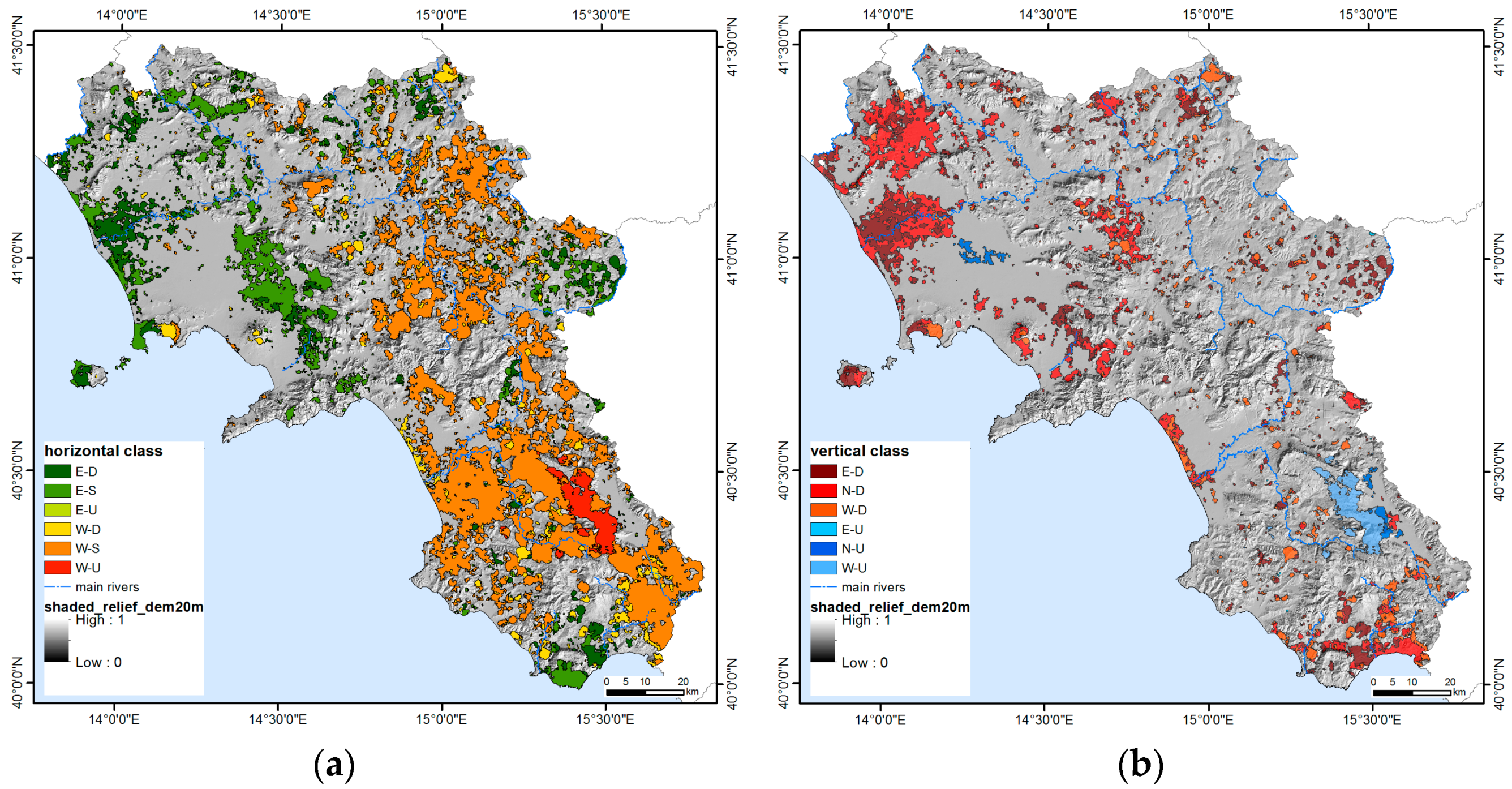
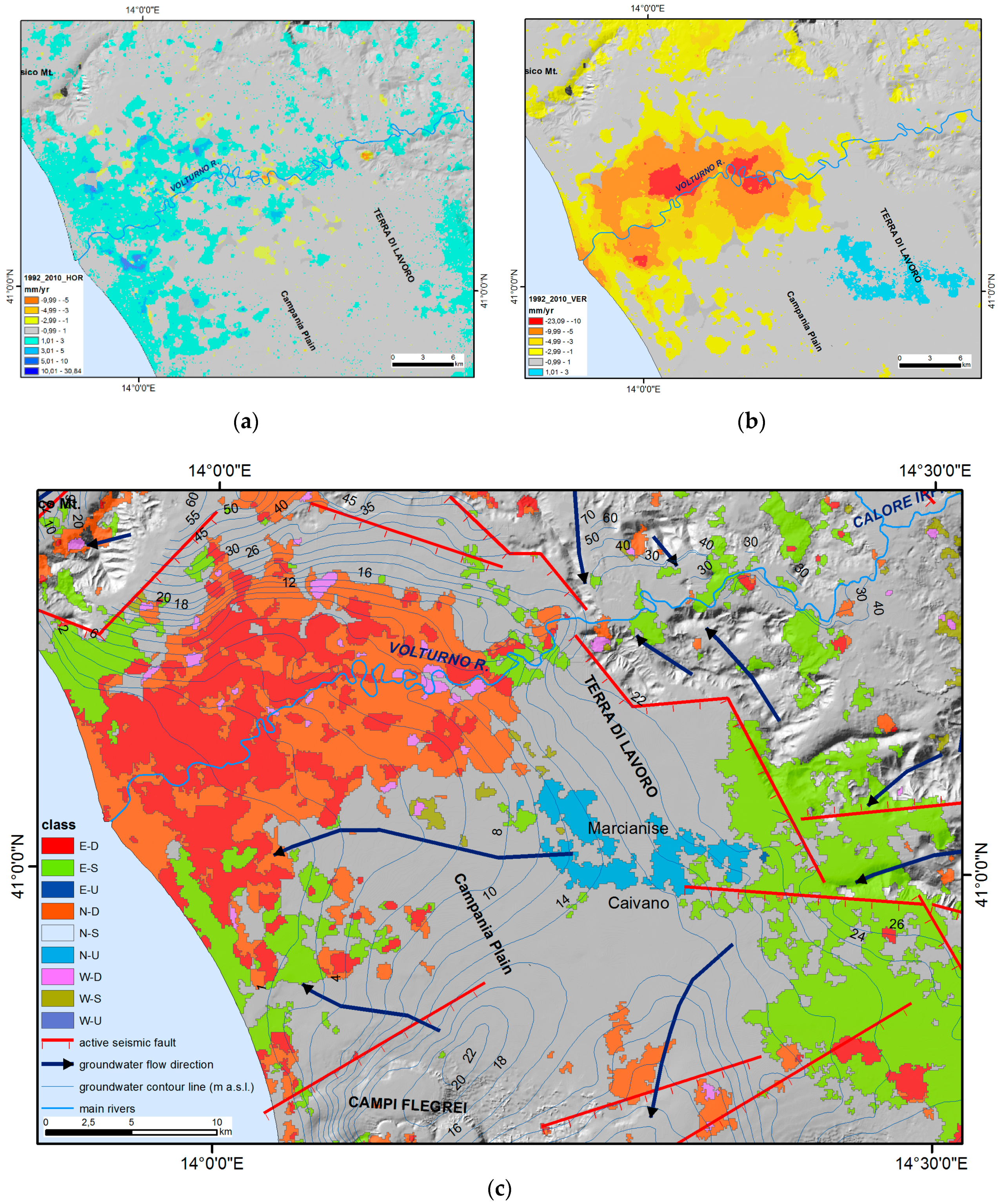
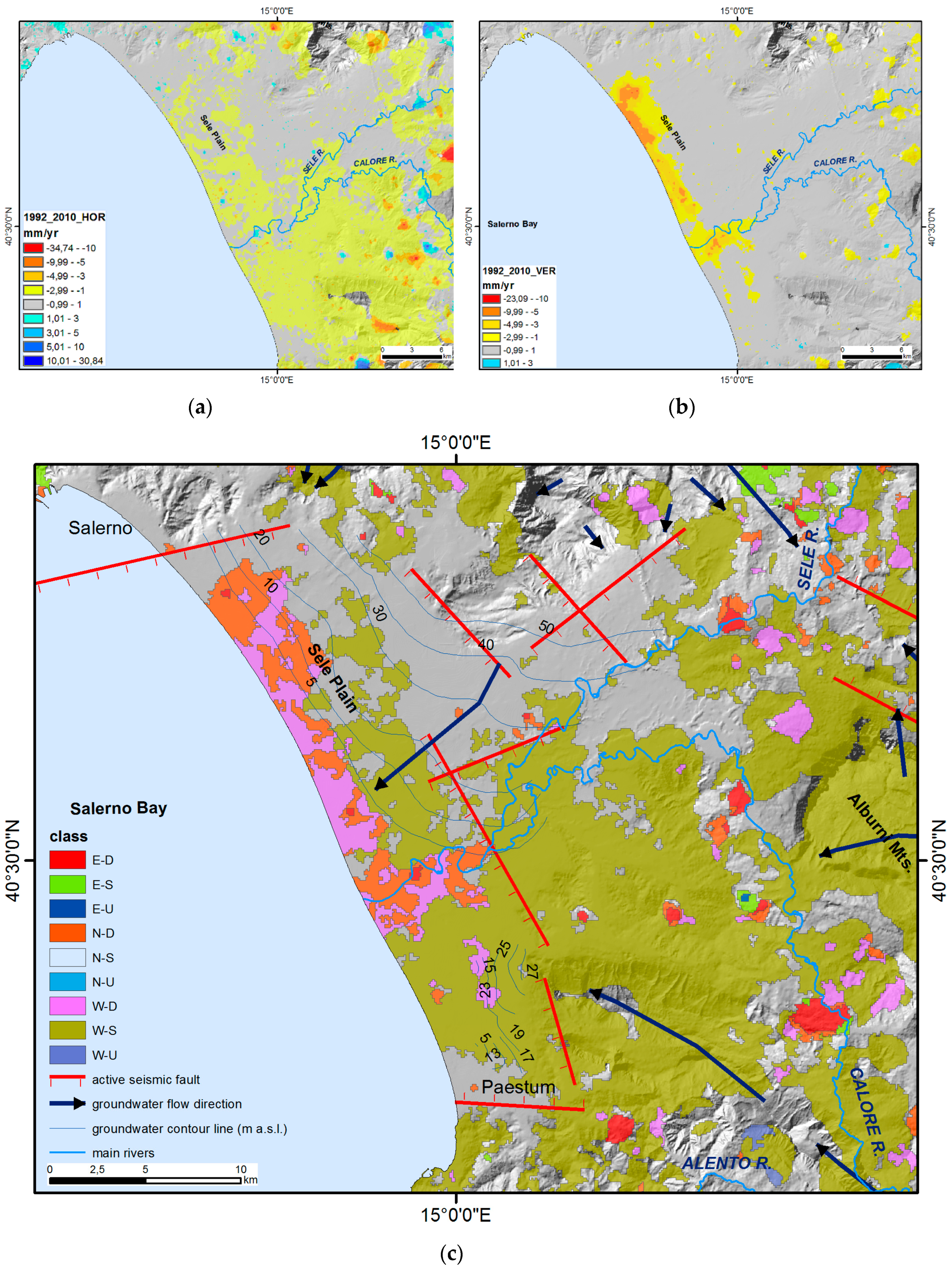

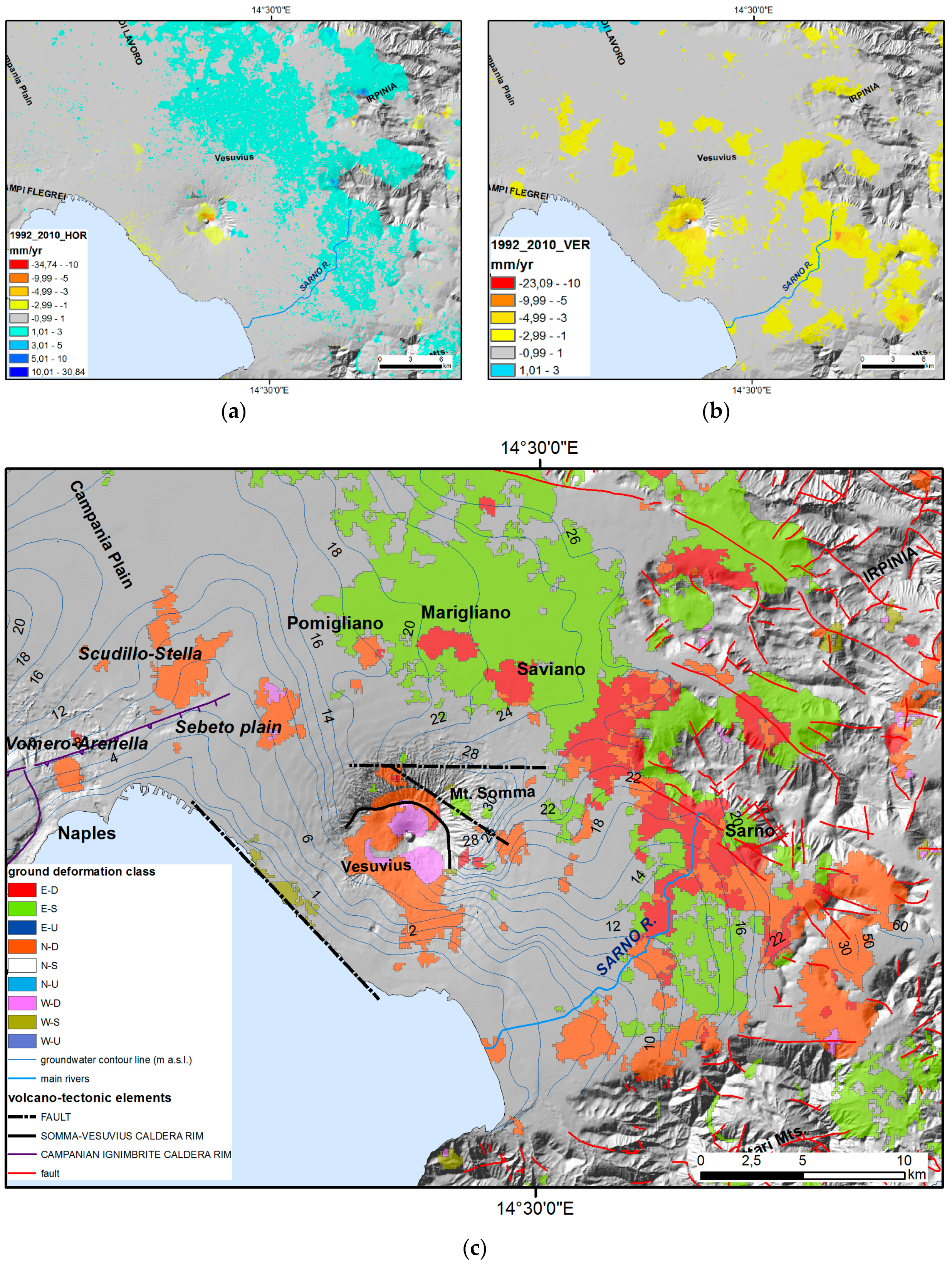
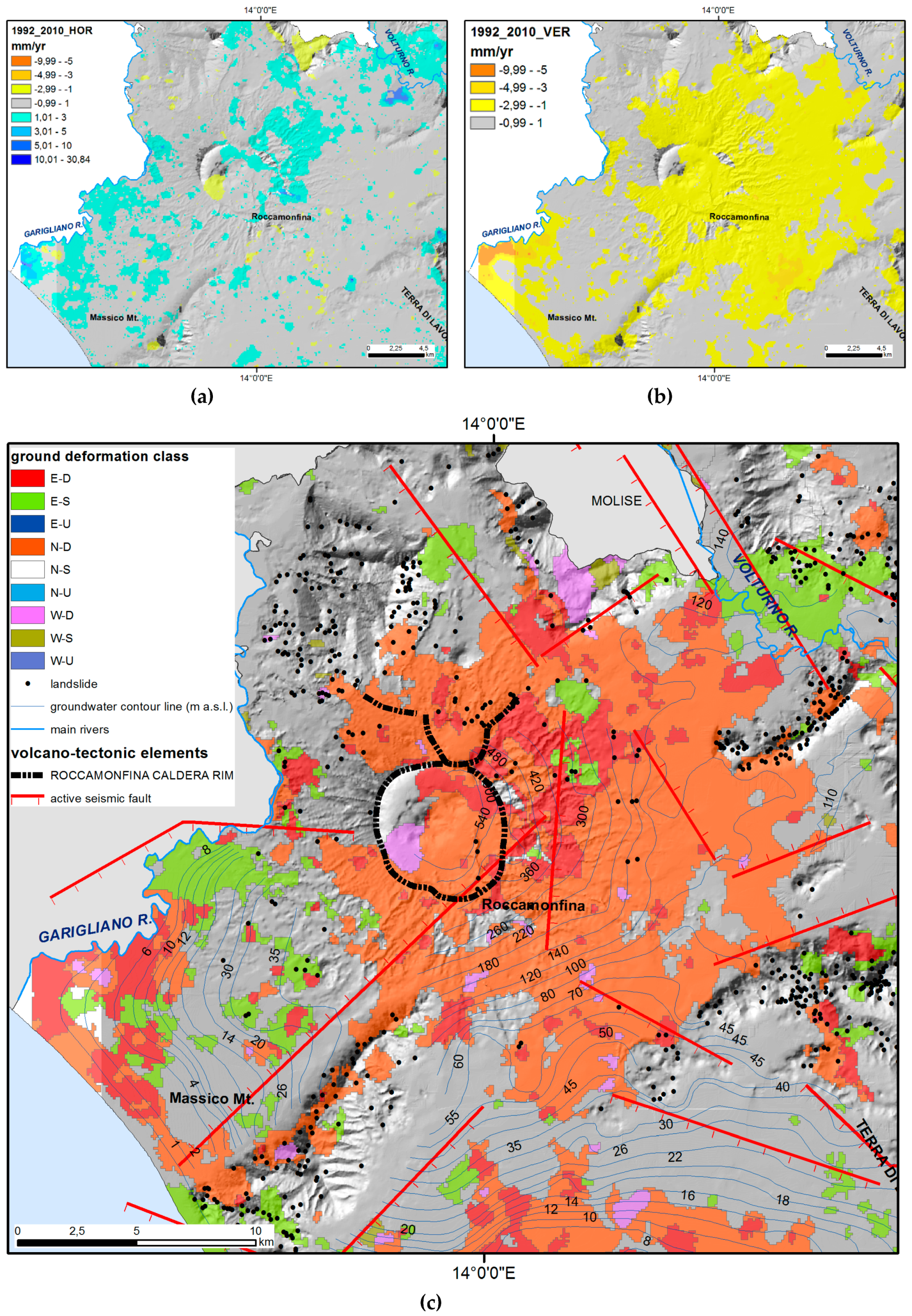
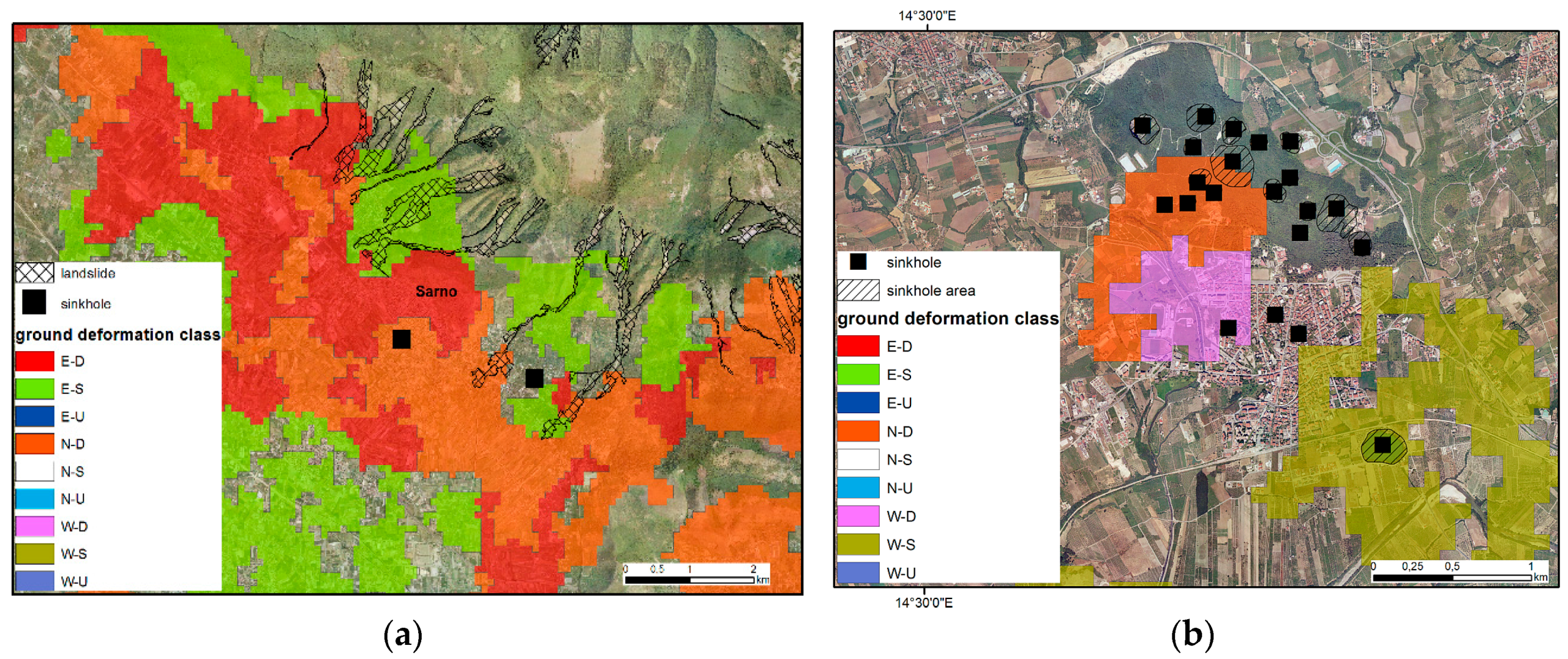
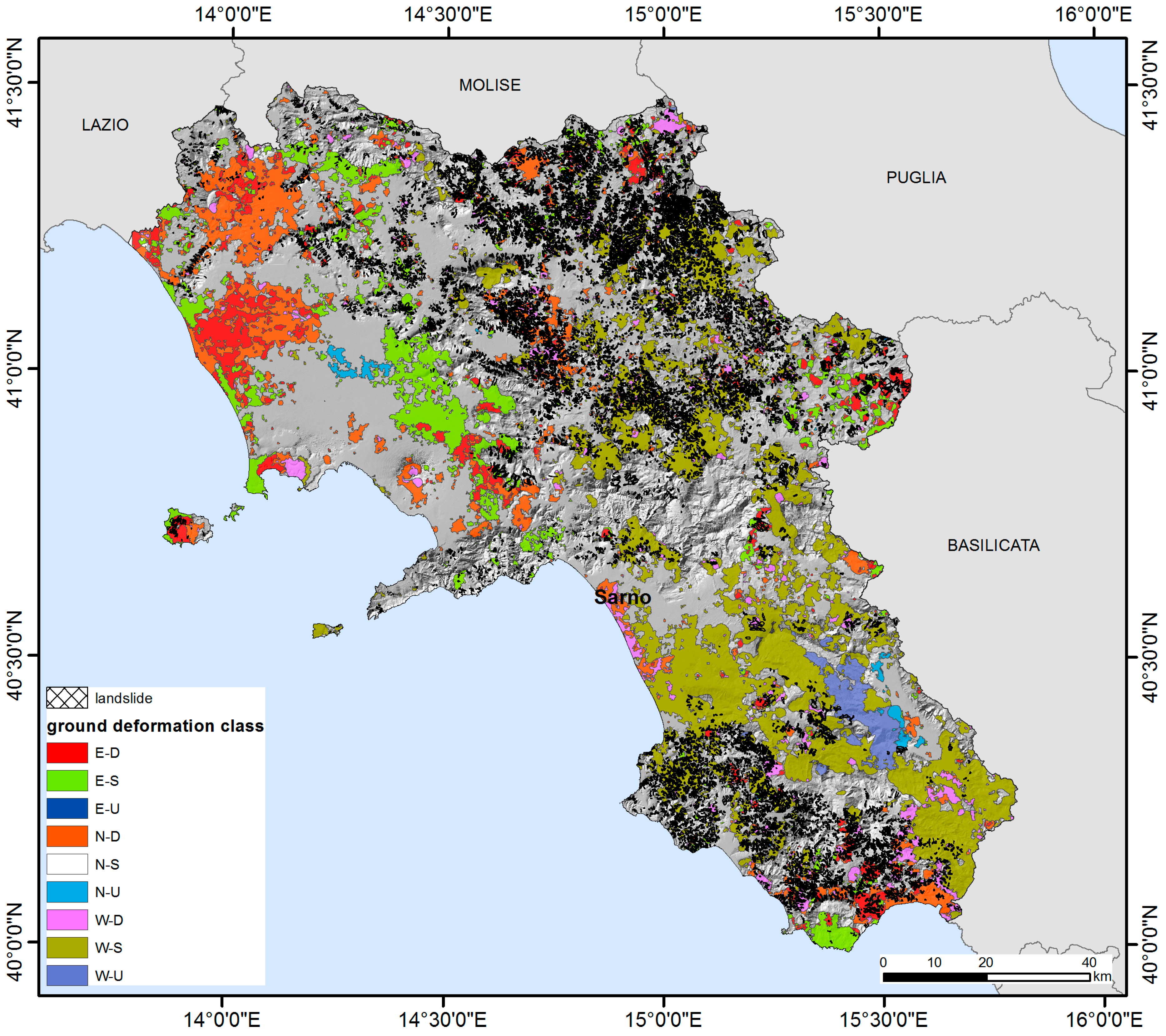
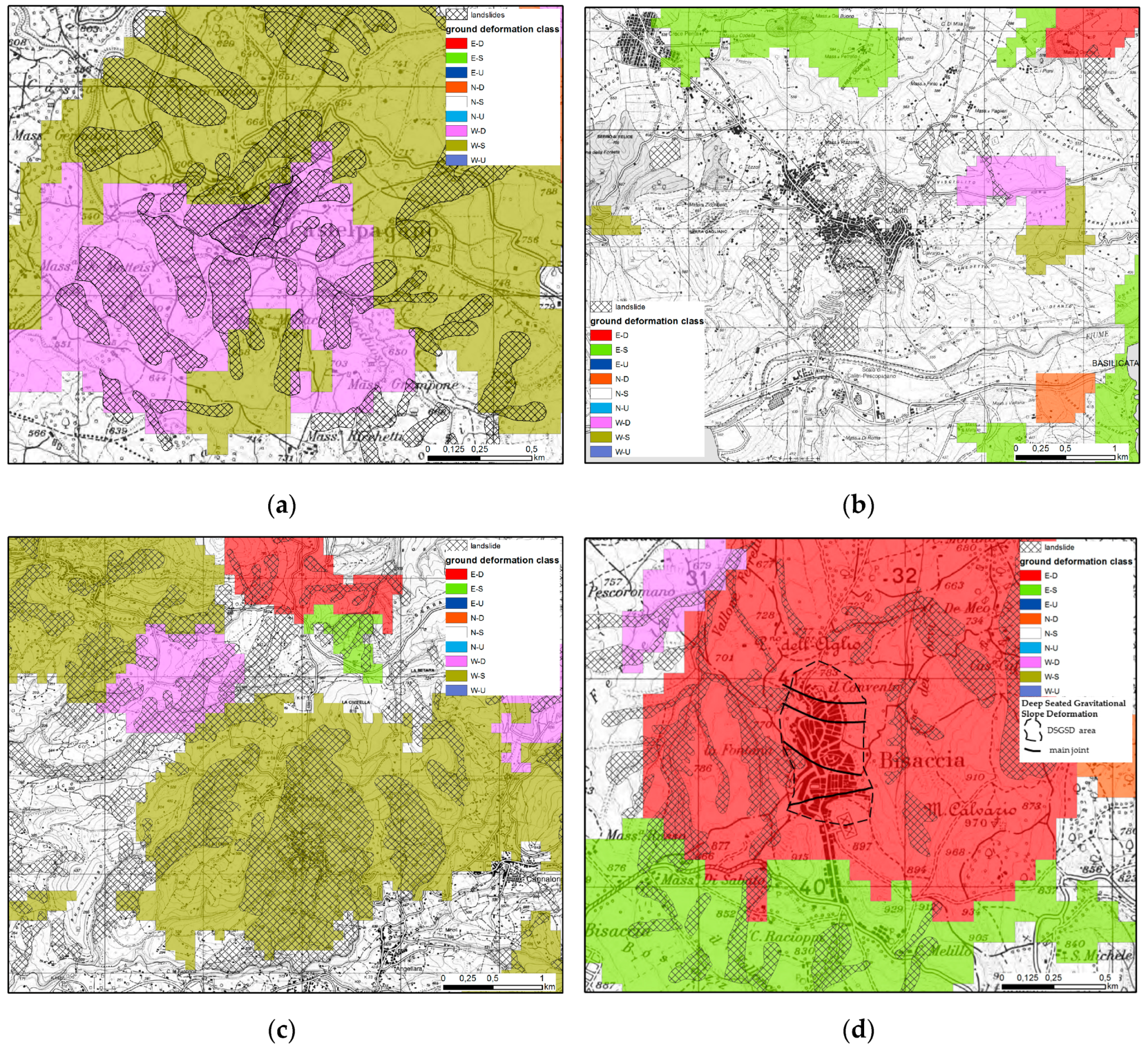
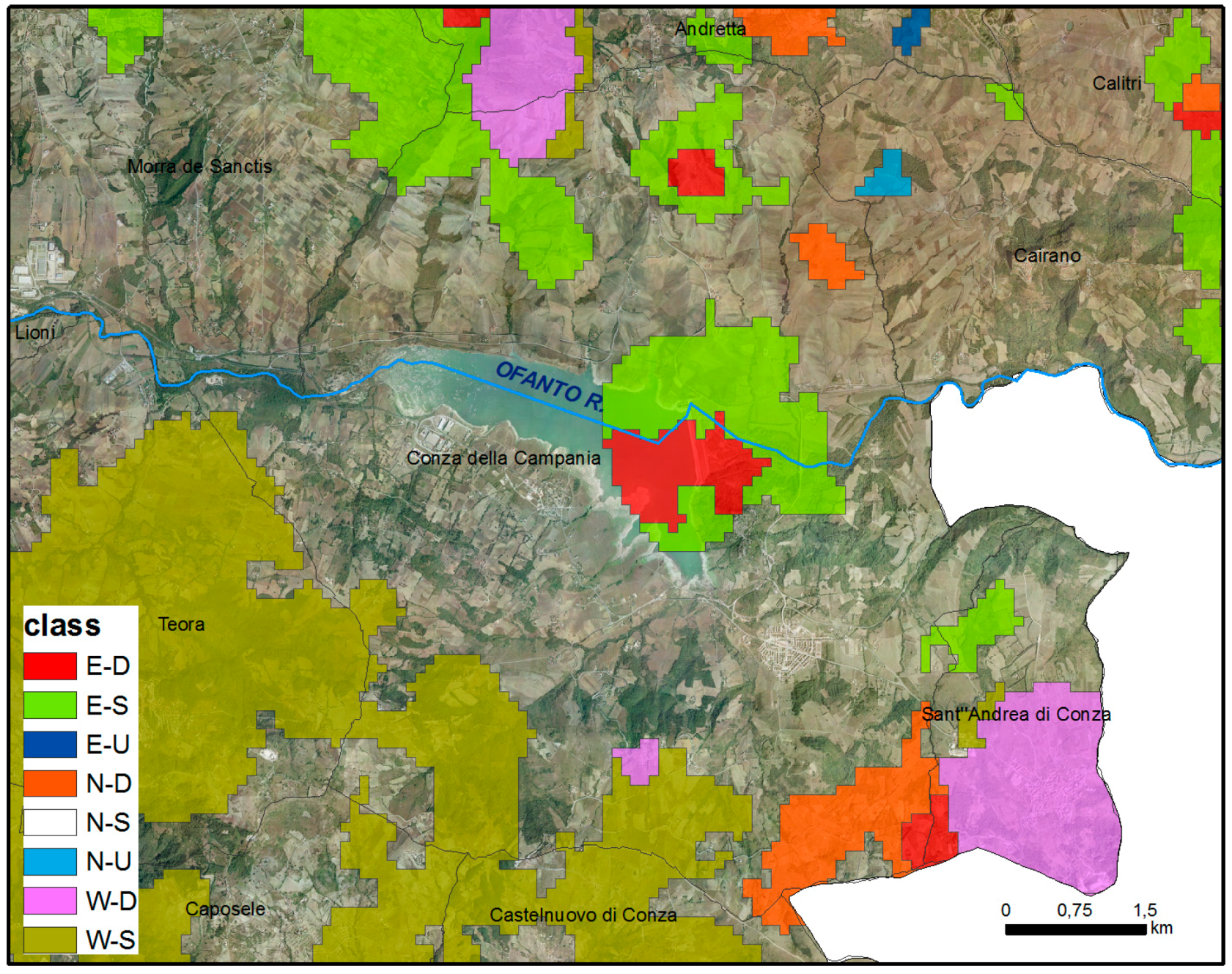
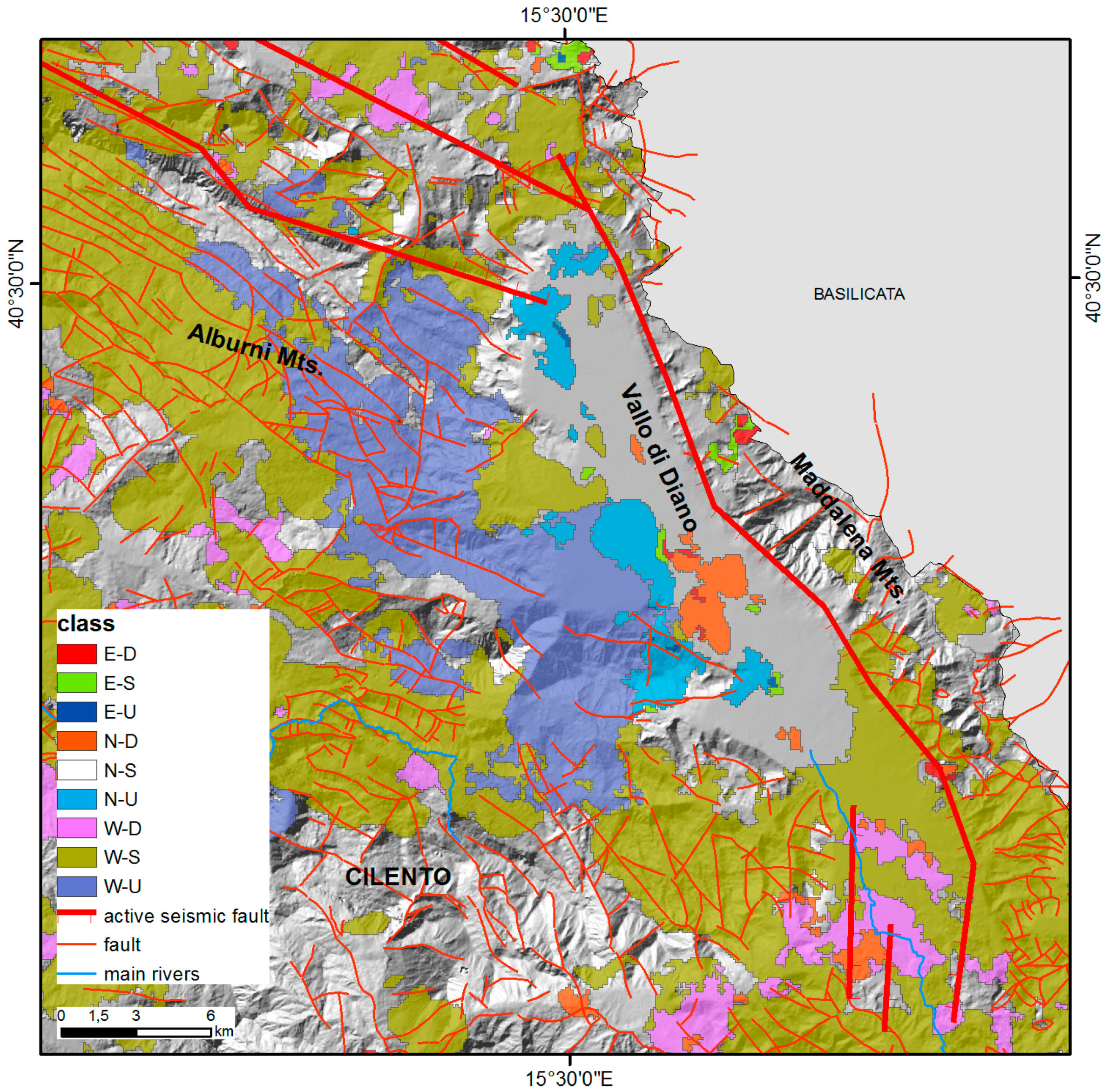
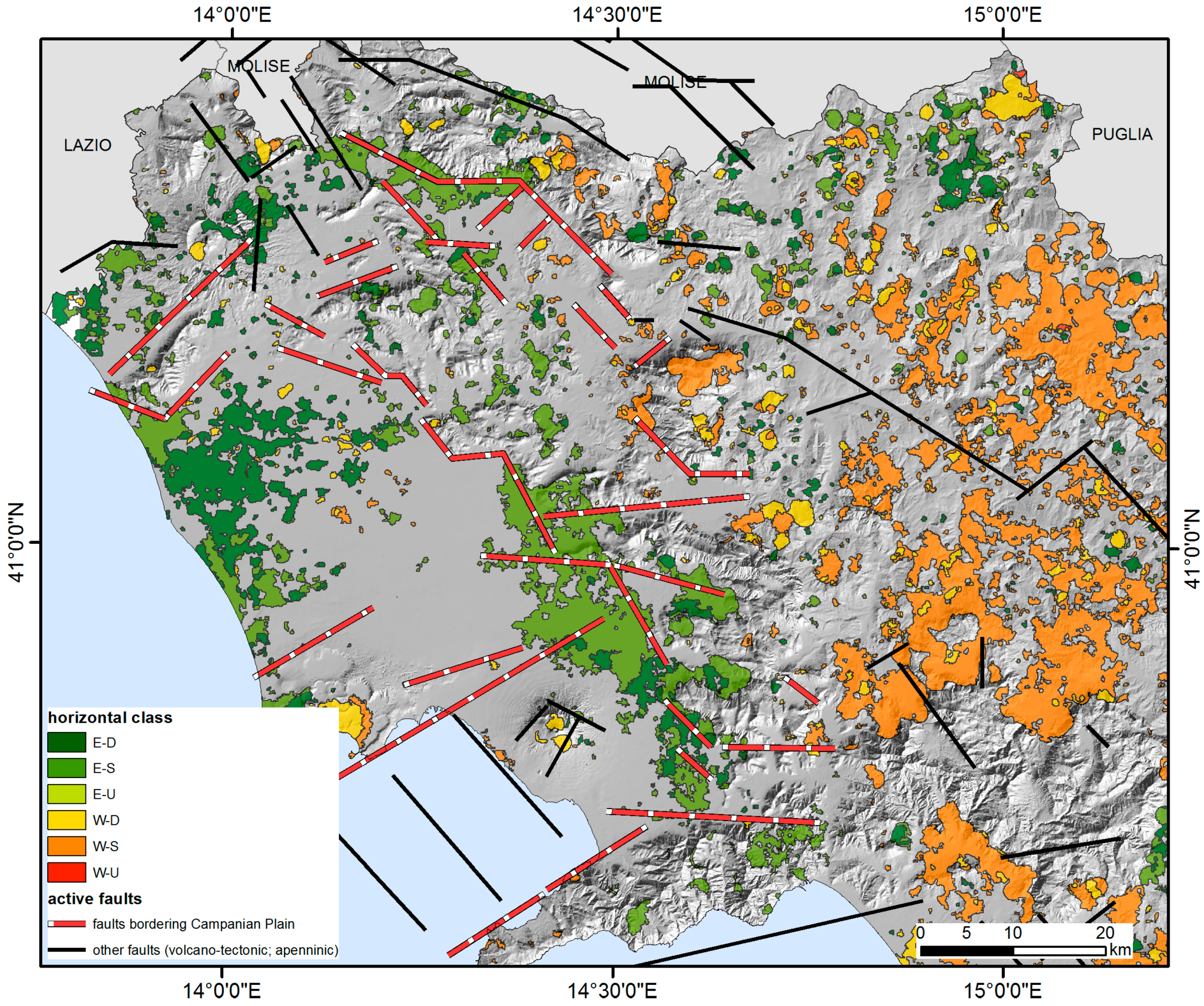
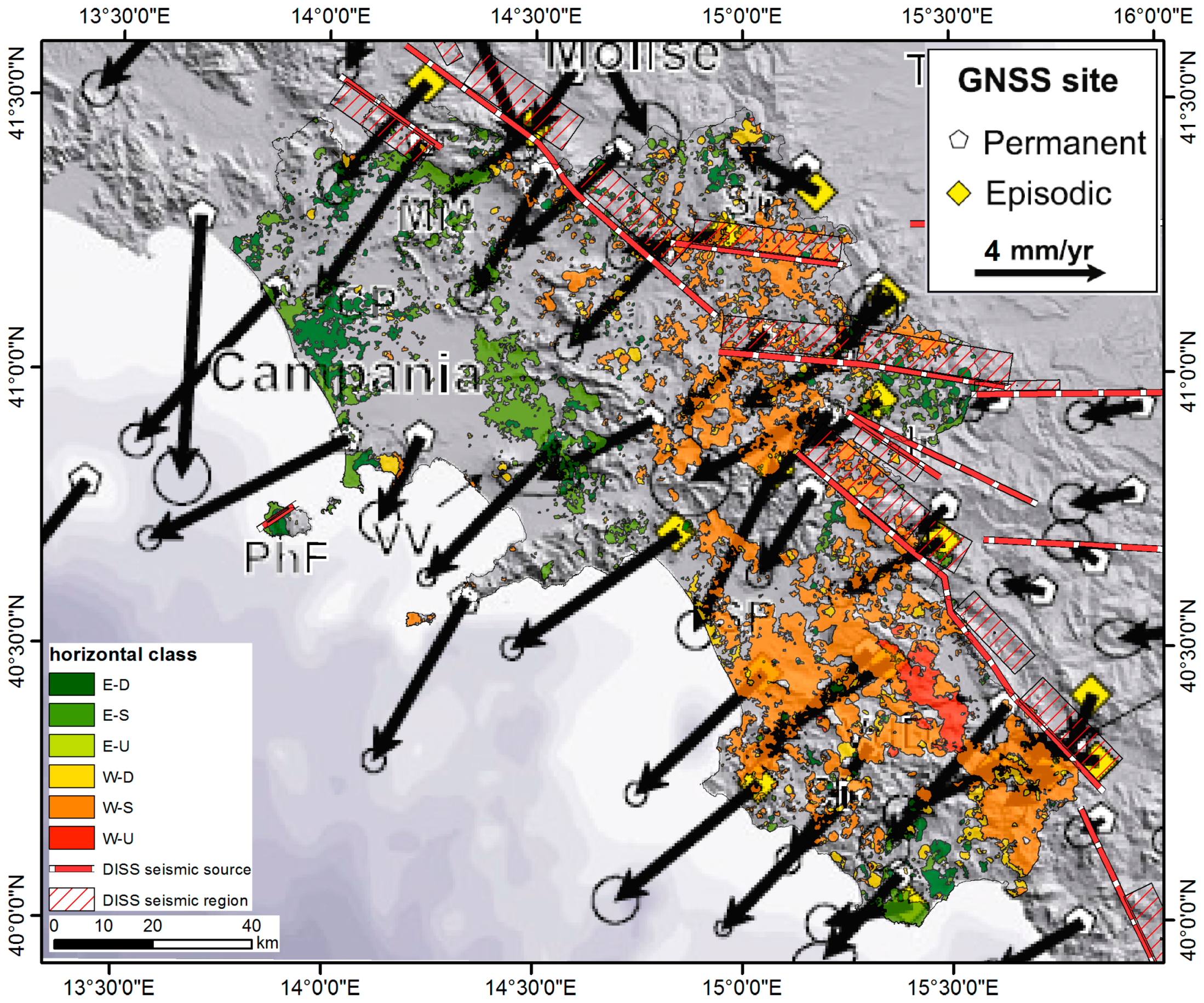
| Satellite-Orbit | Track/Frame | Line of Sight Incidence Angle | Time Range (Used Images for PSI Processing) | |
|---|---|---|---|---|
| ENVISAT-Ascending | 86/798-816 | 22° | 4 May 2003–11 Jul. 2010 | (42) |
| 129/801-819 | 13 Nov. 2002–14 Jul. 2010 | (59) | ||
| 358/801-819 | 29 Nov. 2002–30 Jul. 2010 | (52) | ||
| ENVISAT-Descending | 36/2763 | 25° | 27 Nov 2002–03 Jun. 2010 | (45) |
| 36/2781 | 5 Jun. 2003–03 Jun. 2010 | (40) | ||
| 265/2763-2781 | 8 March 2003–19 Jun. 2010 | (43) | ||
| RADARSAT-Ascending | 104/S3 | 34° | 4 March 2003–15 Sept. 2007 | (52) |
| 204/S3 | 28 Apr. 2003–22 Sept. 2007 | (51) | ||
| RADARSAT-Descending | 11/S3 | 32–33° | 22 March 2003–16 Aug. 2007 | (51) |
| 111/S3 | 5 March 2003–23 Aug. 2007 | (51) | ||
| 211/S3 | 29 Apr. 2003–30 Aug. 2007 | (45) | ||
| ERS-1/2-Ascending | 129/801 | 22° | 14 Jun. 1992–13 Dec. 2000 | (69) |
| 129/819 | 10 Jan. 1993–13 Dec. 2000 | (61) | ||
| 358/801-819 | 8 Sept. 1992–24 Nov. 2000 | (47) | ||
| ERS-1/2-Descending | 36/2781 | 23° | 8 Jun. 1992–11 Jan. 2001 | (81) |
| 265/2781 | 11 Nov. 1992–23 Dec. 2001 | (67) | ||
| 265/2799 | 24 Jun. 1992–23 Dec. 2000 | (72) | ||
| 494/2781-2799 | 10 July 1992–8 Jan. 2001 | (81) | ||
| Satellite-Orbit | PSI Technique | Count | PS Velocity-Mean (mm/yr) | Vel. Stand. Dev.-Mean | PS Coherence-Mean | PS Density (num./km2) |
|---|---|---|---|---|---|---|
| ENVISAT-Ascending | PSP | 1,362,269 | −0.37 | 0.37 | 0.73 | 100 |
| ENVISAT-Descending | PSP | 1,193,312 | −0.44 | 0.44 | 0.75 | 88 |
| RADARSAT-Ascending | PS-InSAR | 628,862 | −1.01 | 1.25 | 0.82 | 46 |
| RADARSAT-Descending | PS-InSAR | 609,915 | −0.67 | 0.80 | 0.84 | 45 |
| ERS-1/2-Ascending | PSP | 606,886 | −0.22 | 0.71 | 0.77 | 45 |
| ERS-1/2-Descending | PSP | 645,042 | −0.35 | 0.69 | 0.75 | 47 |
| Grid Map | Code | Velocity Rate Range | Ground Deformation Component |
|---|---|---|---|
| VG | U | >+1 mm/yr | Uplift |
| VG | S | −1 to +1 mm/yr | Stable vertical |
| VG | D | <−1 mm/yr | Subsidence |
| HG | W | >+1 mm/yr | Westward horizontal |
| HG | N | −1 to +1 mm/yr | Stable horizontal |
| HG | E | <−1 mm/yr | Eastward horizontal |
| Velocity Range (mm/yr) | Area (km2) with Vertical Velocity | Area (km2) with Horizontal Velocity |
|---|---|---|
| >+10 | -- | 6.1 |
| +10 to +5 | 0.1 | 52.4 |
| +5 to +3 | 1.4 | 156.2 |
| +3 to +1 | 220.4 | 1483.7 |
| +1 to −1 | 9684.3 | 7143.0 |
| −1 to −3 | 1976.2 | 2855.7 |
| −3 to −5 | 195.3 | 360.1 |
| −5 to −10 | 157.5 | 85.7 |
| <−10 | 24.9 | 17.2 |
| Total classified | 12,160.2 | |
| No data area | 1439.8 | |
| Regional area | 13,590.0 | |
| Class | Number of Classified Areas | Classified Area Extension (km2) |
|---|---|---|
| N-S | 481 | 7486.77 |
| N-U | 25 | 55.02 |
| N-D | 648 | 991.24 |
| W-S | 558 | 2589.96 |
| W-U | 26 | 153.17 |
| W-D | 510 | 413.35 |
| E-S | 570 | 877.55 |
| E-U | 18 | 4.24 |
| E-D | 444 | 582.75 |
| Total | 3280 | 13,154.24 |
| Area Range (km2) | Number | Total Area (km2) |
|---|---|---|
| 0.1–1 | 2581 | 771.9 |
| 1–10 | 616 | 1714.1 |
| 10–100 | 70 | 1645.8 |
| 100–1000 | 12 | 3152.6 |
| >1000 | 1 | 5869.9 |
| Class | Number of Landslides | Landslide Area (km2) | Landslide Classified Area (%) |
|---|---|---|---|
| W-S | 2486 | 97.9 | 23.8 |
| W-U | 5 | 0.3 | 0.1 |
| W-D | 413 | 14.2 | 3.4 |
| E-S | 292 | 9.7 | 2.4 |
| E-U | 0 | 0.0 | 0.0 |
| E-D | 401 | 14.6 | 3.5 |
| N-U | 1 | 0.1 | 0.0 |
| N-D | 446 | 13.0 | 3.2 |
| N-S | 6918 | 261.7 | 63.6 |
| Classified (total) | 10,962 | 411.6 | 100.0 |
| Not classified | 6791 | 489.3 | 54.3 |
| Total | 17,753 | 900.9 | 100.0 |
© 2019 by the author. Licensee MDPI, Basel, Switzerland. This article is an open access article distributed under the terms and conditions of the Creative Commons Attribution (CC BY) license (http://creativecommons.org/licenses/by/4.0/).
Share and Cite
Matano, F. Analysis and Classification of Natural and Human-Induced Ground Deformations at Regional Scale (Campania, Italy) Detected by Satellite Synthetic-Aperture Radar Interferometry Archive Datasets. Remote Sens. 2019, 11, 2822. https://doi.org/10.3390/rs11232822
Matano F. Analysis and Classification of Natural and Human-Induced Ground Deformations at Regional Scale (Campania, Italy) Detected by Satellite Synthetic-Aperture Radar Interferometry Archive Datasets. Remote Sensing. 2019; 11(23):2822. https://doi.org/10.3390/rs11232822
Chicago/Turabian StyleMatano, Fabio. 2019. "Analysis and Classification of Natural and Human-Induced Ground Deformations at Regional Scale (Campania, Italy) Detected by Satellite Synthetic-Aperture Radar Interferometry Archive Datasets" Remote Sensing 11, no. 23: 2822. https://doi.org/10.3390/rs11232822
APA StyleMatano, F. (2019). Analysis and Classification of Natural and Human-Induced Ground Deformations at Regional Scale (Campania, Italy) Detected by Satellite Synthetic-Aperture Radar Interferometry Archive Datasets. Remote Sensing, 11(23), 2822. https://doi.org/10.3390/rs11232822




